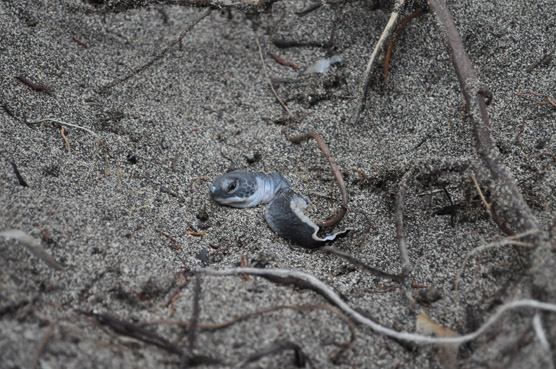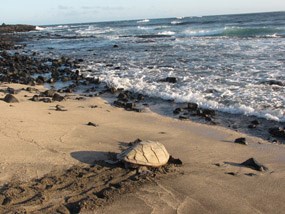|

Contact: Jessica Ferracane, 808-985-6018 Contact: Will Seitz - Turtle Recovery Project Coordinator, 808-985-6090 Hawaii Volcanoes National Park, HI - Hawaiʻi Island Hawksbill Turtle Recovery Project recorded one of its most historic sea turtle nesting seasons in 22 years, including the first recorded green turtle nesting on the island of Hawaiʻi, a rare daytime nesting by a hawksbill turtle, and an increase in the number of newly tagged female hawksbills. 
In the 2011 report released today, a female green turtle, or honu, was first observed attempting to nest on the beach in front of the park's remote Halapē campsite. She then traveled 52 coastal miles southwest and nested at Pōhue Bay. Her historic nest was a success, with 40 baby honu reaching the ocean. Green turtles are federally listed as threatened, are indigenous to Hawaiʻi, and are seen throughout the islands. They typically nest in the French Frigate Shoals, but there have been occasional documented nestings by honu on the other main Hawaiian Islands. Also within Hawaiʻi Volcanoes National Park, a female honu ʻea, or hawksbill turtle, was observed nesting at ʻĀpua Point at noon, the earliest daytime crawl in project history. Hawksbill turtles are endangered, and nest primarily at beaches along the southern coast of Hawaiʻi Island at night. Volunteers helped an estimated 3,000 hatchlings reach the ocean from a total of 30 nests (one green, 29 hawksbill) along five of the beaches they monitor: ʻĀpua Point, Halapē, Kamehame, Kōloa, and Pōhue Bay. "Without the help from over 20 dedicated volunteers this season, many of these hatchlings would not have made it to the ocean. Thanks to them, there is hope for the survival of honuʻea" said Will Seitz, project coordinator. Other season highlights included a nest excavation with third grade students from Volcano School, and a continued increase in the number of newly tagged honu ʻea females. Out of the nine female adult hawksbill turtle observed, five were newly tagged while the rest were returnees from previous seasons. During nesting season, from May through December, females come ashore to lay clutches of eggs. The eggs are vulnerable during the two-month incubation, and are preyed upon by mongoose, rats, feral cats, and dogs. After the hatchlings emerge they can become caught behind rocks or vegetation, disoriented by artificial lights, run over by vehicles, or eaten by mammals and birds. Volunteer efforts are critical to their survival. For more information on how to help, visit www.volunteer.gov/gov, or contact the Hawksbill Project at 808-985-6090. -NPS- |
Last updated: February 28, 2015
